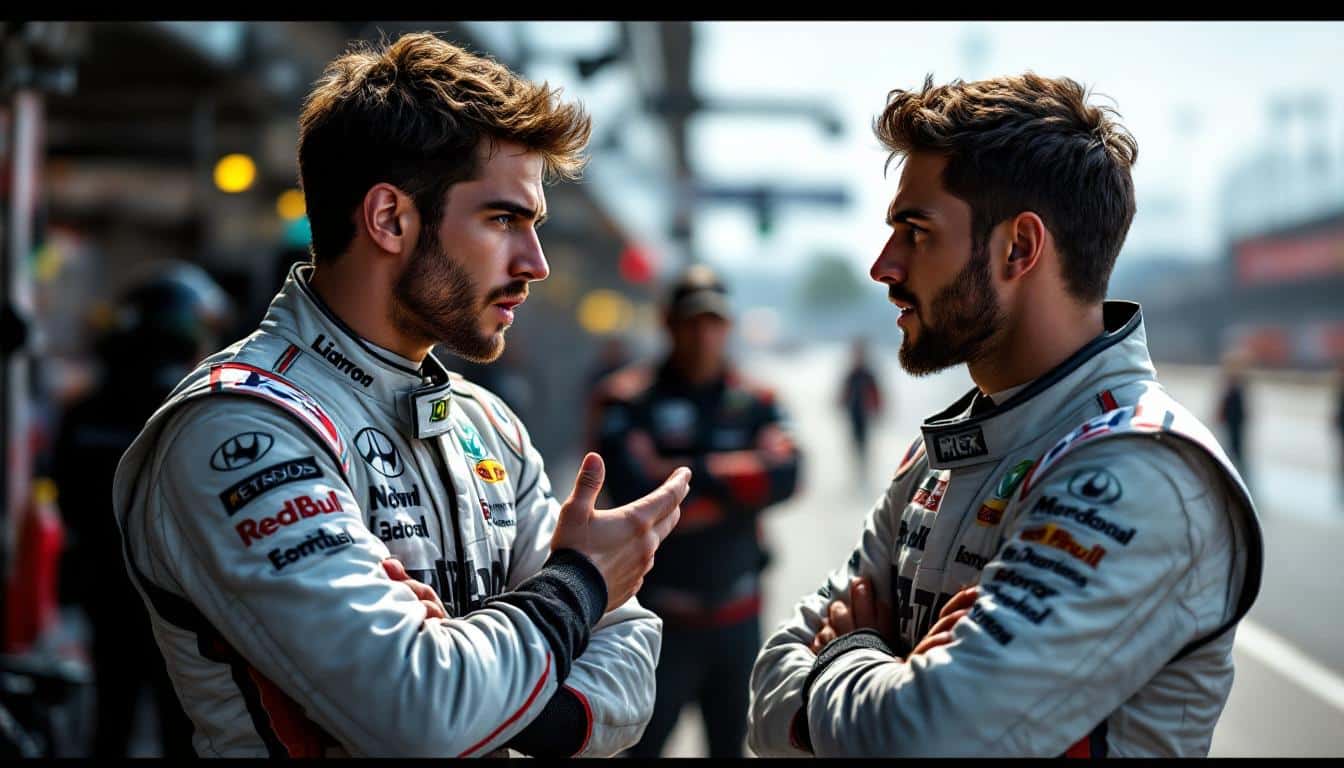The roar of engines, the smell of burning rubber, and the thrill of speed. Formula 1 is a spectacle unlike any other, capturing the hearts of millions worldwide. As teams strategize and drivers push their limits, the drama unfolds on circuits around the globe.
The narrative of motorsport often pivots around the dynamic between teammates, particularly when the pressure mounts. Take, for instance, Isack Hadjar, who finds himself in the spotlight as the leading rookie driver this season. His recent experiences alongside Liam Lawson at Red Bull highlight the challenges of adapting to high-stakes racing, particularly after Lawson’s challenging stint with the team. With Yuki Tsunoda stepping into Lawson’s shoes, Hadjar reflects on the difficulties both drivers faced without delving deeply into the reasons behind their struggles. Despite a fantastic start to his own campaign, Hadjar acknowledges the need for further growth and understanding, especially regarding the complexities of an F1 car. Each race offers a new opportunity, and the lessons learned from the track become vital in the pursuit of excellence.

In the world of Formula 1, the dynamics between drivers can often shape the narrative of a season. Recently, the conversation surrounding Liam Lawson and Isack Hadjar has prompted intriguing questions, particularly regarding the former’s short stint with Red Bull Racing. Lawson found himself grappling with the intense pressure of competing alongside a seasoned champion like Max Verstappen, a challenge that ultimately led to his return to the sister team. Hadjar, who is emerging as a standout rookie, has chosen to sidestep discussions about this sensitive topic, reflecting his approach to complex relationships within the paddock.
The relationship between teammates in Formula 1 can be fraught with tension, especially when performance and expectations are closely scrutinized by the media and fans alike. Isack Hadjar’s reluctance to discuss Lawson’s transition away from Red Bull highlights his awareness of the emotional toll such subjects can take on their friendship and competitive bond. For a driver still making his mark, navigating these conversations can be tricky, particularly when they revolve around a teammate’s struggles. Hadjar’s choice to maintain a distance from the topic illustrates his desire to focus on his own performance and growth rather than engage in potentially uncomfortable discussions about Lawson’s brief tenure with the team.
To delve deeper into this topic, it’s vital to understand the context around Lawson’s experience at Red Bull. The high-octane environment of F1 can lead to rapid judgments and the assessment of a driver’s abilities based on results from just a few races. After two disappointing rounds, Lawson was replaced by Yuki Tsunoda, a decision that can weigh heavily on a driver’s psyche. The abrupt end to Lawson’s time in the spotlight may have left lasting impressions, which is likely why Hadjar has chosen to distance himself from the subject. It’s clear that his priority lies in developing his own skills without unnecessary comparisons to his teammate’s challenges.
Why is the topic of liam lawson so sensitive?
Liam Lawson’s situation at Red Bull racing serves as a poignant reminder of the pressures within Formula 1. The expectation to perform at optimal levels can lead to dire scrutiny, particularly when a driver is in the spotlight for the first time. Lawson’s struggles during his short stay with the team made headlines, as his performances alongside Verstappen were not up to par. Understanding this context is critical for recognizing why Hadjar may avoid discussing Lawson’s experience.
The pressure on young drivers in F1 is immense, and the fear of failure can overshadow their innate talent. Lawson, still in the early stages of his career, faced the daunting task of measuring up to one of the best in the sport, Max Verstappen, who constantly sets the benchmark for speed and skill. Such experiences can leave a driver feeling vulnerable, creating a reluctance to openly discuss personal challenges. Hadjar’s decision not to engage in conversation about Lawson’s time at Red Bull can be viewed as a gesture of solidarity and compassion. He recognizes that talking about these experiences may not only reopen wounds for Lawson but also steer the conversation away from their respective journeys as emergent talents in a highly competitive environment.
Furthermore, Hadjar has showcased a maturity that is impressive for his age. By consciously choosing to avoid sensitive topics, he demonstrates his understanding of the intricate web of relationships that exists within the sport. It fosters an environment where both he and Lawson can navigate their careers without the added burden of past experiences weighing them down. This approach enables Hadjar to shine in his own right, focusing on his current achievements rather than being overshadowed by his teammate’s past trials.
How have isack hadjar’s performances shaped perceptions?
Isack Hadjar has emerged as a key figure in the current F1 season, standing out not only for his talent but also for his capability to adapt and thrive in competitive situations. With 21 points garnered across the first ten rounds and consistently avoiding first-round eliminations, Hadjar has certainly made a name for himself as one of this season’s most promising rookies. His performances have shifted the spotlight towards him, especially as discussions about potential seat changes for the next season begin to loom.
Hadjar’s trajectory of improvement and his focused mindset have created a favorable perception among fans and analysts alike. His steady performance has had a ripple effect, with many suggesting that his recent success might place him in contention for a seat alongside Verstappen at Red Bull in the future. This scenario creates an interesting parallel with Lawson’s previous experiences, yet Hadjar’s ability to manage this pressure while still avoiding sensitive topics is commendable.
The clarity with which he approaches racing indicates a level of maturity that contrasts sharply with the challenges faced by Lawson. By highlighting his lack of experience with a “tricky car,” Hadjar has acknowledged the complexity of the F1 landscape while simultaneously reinforcing his competency. Such insight signifies a forward-thinking mindset, as he understands that skill development extends beyond sheer speed. There’s an intricate balance of technical knowledge and practical experience that can make or break a season for drivers.
Yet, even as he thrives, Hadjar recognizes that there’s always room for improvement. His self-awareness about needing to experience more challenging driving conditions reflects a desire to become a well-rounded driver. This growth mindset will be crucial as he progresses further into the challenging world of Formula 1. By maintaining the focus on his journey rather than the past struggles of his teammate, Hadjar demonstrates an understanding of the sport’s intricate nature, ensuring his ascent is unimpeded by unnecessary distractions.
What can we learn from this dynamic in the paddock?
The relationship and dynamics between Liam Lawson and Isack Hadjar not only provide insight into their personal journeys but also reflect larger themes in the world of Formula 1. The sport is as much about the camaraderie and competition between teammates as it is about individual performance. Hadjar’s choice to avoid the topic of Lawson underlines a significant lesson: sometimes, the best way to support someone is to let them heal and find their place in racing without the pressure of scrutiny.
Furthermore, this incident sheds light on the importance of mental health and psychological resilience in motorsport. Young drivers face precarious situations that can generate undue stress and pressure; acknowledging these challenges is essential for the progression and well-being of all athletes. Both Lawson’s journey and Hadjar’s reaction provide a much-needed conversation about supporting each other in competitive fields.
In a sport where the stakes are incredibly high, the manner in which teammates interact can significantly influence their performance on and off the track. The sensitivity surrounding Lawson’s situation manifests as an opportunity to cultivate a supportive atmosphere where drivers can develop without the fear of public judgment. Moreover, it teaches us that personal growth often comes at varying paces, and the most valuable lessons are sometimes found in the quiet moments of reflection and support rather than in the limelight of competition itself.
As we observe the unfolding stories in F1, it’s clear that the relationships formed within the paddock can offer as much intrigue as the races themselves. Ultimately, these interactions help shape not just the careers of young drivers but the future of Formula 1 as a whole. By fostering an environment of understanding and collaboration, the sport can continue to thrive, encouraging the next generation of talent to face the challenges of racing with resilience and support.


